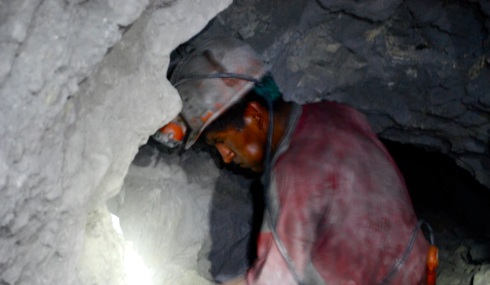
Candelaria mine, Cerro Rico, Potosí, Bolivia. The mines – which have claimed millions of lives – are still being worked today.
Jupapina, near La Paz, Bolivia
[by Paula]
We’ve just spent our third Christmas and new year away from home. As we’re living in a proper house and have been temporarily adopted by Emma, Rolando and family, it was more like a ‘normal’ Christmas than the others. There was the build-up, with drinks parties, visits from Santa (one of which looked suspiciously like JD…) , and even some shopping for presents. There was turkey and bread sauce, there were roast potatoes, and there were Boxing Day leftovers. New year’s eve involved way too many cocktails. So no change there then.
But that’s enough of the happy smiley Santa stories – it’s the 5th of January and we’ve all had enough of that, so we’ll move straight on to the gritty stuff.
Between Christmas and New Year we arranged some time off and made a plan to visit the cities of Potosí (the highest in the world) and the official capital of Bolivia, Sucre. When we told Emma of our plans she said: “Oh, Potosí. You should go, but I really think it’s the saddest place in South America.”
A story of colonial brutality, staggering injustice, oppression, terrible working conditions and death on an unimaginable scale? All the more reason to go and find out what it’s all about, we said.
There’s a conical mountain that dominates Potosí, looming over it from almost every angle. For nearly 500 years Cerro Rico – or Rich Mountain – has been mined for silver, since the Spanish decided they’d like a piece of it in 1545.
Back then, and for hundreds of years hence, the mountain yielded unfathomable riches. At its height Potosí was bigger and more important than London or Paris. Did Bolivia benefit? If you’ve ever read a word of colonial history, you’ll know the answer is a big fat, shiny, no.
Not only that, but some 8 million miners lost their lives in the 300 years that the Spanish enslaved indigenous Bolivians and imported Africans to toil underground.
It is known as the ‘mountain that eats men’. During colonial times people were, hardly surprisingly, petrified to go down there. They knew that only three in 10 of them would survive – if they didn’t perish in an accident, they would be poisoned by mercury, or die from dust-clogged lungs.
On the other hand, Potosí’s mineral wealth help fund Europe’s industrial revolution so, you know, every cloud…
Bolivians say that enough silver was extracted from Cerro Rico to build a bridge of silver between South America and Spain. The problem is, the flow of money across that ‘bridge’ was pretty much one way.
In that respect Potosí is a microcosm of everything that was shameful about the colonial period itself, and how it paved the way for continuing exploitation. In this case it was the Spanish, but the same pattern applies in other continents thanks to the British, French, Dutch, Belgians, Italians, Portuguese and others.
The Spanish came with their language, their religion, their diseases and their ideas of superiority. They saw glittery stuff and they wanted it. They brought misery and death to indigenous people on a staggering scale. They crushed ancient civilisations, siphoned off all the family silver and built their futures off the back of it, while ensuring that development in the colonies was stifled and dependency secured.
“If it were not a futile exercise, Bolivia — now one of the world’s most poverty-stricken countries — could boast of having nourished the wealth of the wealthiest.
“In our time Potosí is a poor city in a poor Bolivia: ‘The city which has given most to the world and has the least,’ as an old Potosían lady told me. Condemned to nostalgia, tortured by poverty and cold, Potosí remains an open wound of the colonial system in America: a still audible ‘J’accuse’.”
Eduardo Galeano, The Open Veins of Latin America
And their mission to convert the indigenous people to Catholicism was helped along by the building of numerous lavish churches in the city, using the proceeds of slave labour in the mines. It’s said that although God ruled in Potosi’s 34 churches, the Devil laughed in his 6,000 mines.
The ripples of those deliberate colonial-period policies are still very much felt throughout the world. Today, the department of Potosí is one of the most poverty-stricken in Bolivia, and Bolivia is one of the poorest countries in South America.
The Bolivian coins that were once made in Potosí are now manufactured in Chile, Canada and Spain.
The previous day, at the spectacular Casa Real de la Moneda (the ‘royal mint’ house) museum, we had heard of a sunken Spanish galleon, which went down in 1622 full of Potosí silver coins. It was searched for and recovered off the coast of Florida by a US citizen, in 1985, containing an estimated $3billion worth of silver. Now, fair play to him for his efforts and all that. But when Potosí launched a claim to have their heritage returned to them, they received a donation of one coin. Yes, one. You can go and look at it in the museum or, if you like, buy one of the coins on eBay for hundreds of dollars.
As for Cerro Rico, miners are still grafting in the mountain, which is now slowly collapsing after nearly half a millennium of extraction. For thousands of men from this region, and beyond, there is nothing else to do but mine.
These days they are scratching a living from smaller and smaller veins of silver – plus lower value metals like tin and lead – in alarmingly primitive conditions.
Modern equipment, safety gear and regulations appear to be luxuries no one can afford. Although progressive in many other ways, the Bolivian government has taken a hands-off approach to Cerro Rico’s mines, which they officially own but lease to a network of powerful co-operatives that apparently resist too much intervention.
Most Cerro Rico miners will fall victim to the fatal lung disease silicosis after an average of 15 years of work, while collapses and other accidents also claim many lives.
About 800-1,000 mine workers are children, whose families need the money. Miners of all ages often work horrendously long shifts, their cheeks distended with the coca leaves they chew to stave off hunger and exhaustion.
It is possible to do a tour of the working mines and, after a bit of consideration, I decided to go down there. Jeremy declined, because he didn’t think he’d be able to tolerate the claustrophobic and cramped conditions. Signing the waiver before the tour was a stark reminder that the mines are genuinely dangerous and that there’s not much that can be done for you if there’s a collapse.
It’s not an enjoyable experience, but that’s not the reason for going. I am not claustrophobic as such, but let’s say I’d put going caving very near to the bottom of my ‘to do’ list. I’d far rather jump out of a plane than squeeze into a dusty hole underground.
It was Sunday 29 December, so there were not many miners working on the day we visited. This was, in some ways, a pity but in other ways it was far safer. Fewer explosions, and no rock-laden trolleys hurtling into our path.
We headed into the darkness, splashing through cold muddy water and crouching to avoid jagged rocks, and low-slung pipes carrying compressed air. I smacked my head countless times. The level of the ‘roof’ changed constantly and the atmosphere, helmet, headlamps and darkness were phenomenally disorientating.
After about 15 minutes, four people out of our group of seven had turned back. This is apparently quite common. The further in you go, the hotter and dustier it becomes. I started coughing as soon as we hit the dust, and yet most miners don’t wear masks.
Before long we came across a lone miner, Basilio, who had been working in the mine for 28 years. I was astonished that he was allowed to work alone. Our guide Daniel said no one even keeps a list of who is working on any given day. Basilio was working only for himself – he needed the money so had come in while most people were taking a new year break. Most tourists bring ‘gifts’ of dynamite, coca leaves, cigarettes or drinks for the miners – we gave everything we’d bought to him.
He had let off some dynamite below and was waiting for the dust to clear. ‘Do you want to see where he is working?’, said Daniel. We did. It would require squeezing through a hole into the dusty abyss on the level below. We slipped and skidded, grabbed onto rocks that crumbled in our hands, and finally made it to the cave below.
This was not your standard tour – it was horribly unsafe and because we had to go one-by-one we couldn’t help each other to get down.
When we got to Basilio’s ‘space’ it was pretty horrifying – dark and cramped, with air so thick you could have sliced it. He was manually chiselling rocks to make holes for further dynamite explosions. He had apparently spent weeks carrying rocks to the level above, to make space to work. With every action he grunted and breathed in more dust, the sweat lashing off his brow.
I was particularly fascinated by how the miners go to the toilet when they are down there for up to 24 hours. Apparently they just “pee anywhere” (“no2s outside”) but, astonishingly, there is no smell. Anyone who’s travelled in Latin America will remember the ubiquitous smell of urine, drying on sun-baked street corners. So how is it possible that millions of men have been peeing in an enclosed space for 500 years, without any discernable odour? Answers on a postcard please.
Before heading out we crawled through a tiny tunnel to pay an obligatory visit to ‘Tio’. Every mine on Cerro Rico has its own Tio – an ugly cigarette-smoking statue with horns, an unmissable erection and very bad teeth, who represents the devil. Miners say they believe in God in the outside world, but when they enter the mountain they are in Satan’s territory. Tio is lavished with gifts like coca leaves and alcohol, so he’ll protect the miners and prevent accidents.
There’s a well-known docu-film called the Devil’s Miner, which features two young brothers who worked in the mines. Among the most poignant scenes are those of the older brother (also called Basilio) trying to help the younger, Bernardino, become accustomed to this terrifying Tio statue, which they often visit alone in the darkness.
Some people rightly ask why child labour is tolerated in the mines. It’s a complicated question but the Devil’s Miner provides a decent insight into how that can happen. Basilio and Bernardino were working on Cerro Rico to support their fatherless family. Their mother earned US$25 a month. Clothing her three children for school – with mandatory uniforms – cost nearly two months’ wages, so they needed more coming in if the kids were to get their education, and eat.
So the boys crammed in their school lessons and a job in the mine into each day.
“Going to school is like a vacation, even for half a day,” said Basilio, who was 14 when the film was made in 2005. This is despite the sad fact that other kids gave them abuse if they found out they were working in the mountain – calling them names like ‘rock thief’ and ‘dust sucker’.
He hoped the job was only temporary. The reality is that the majority of child miners never leave Cerro Rico.
“But I don’t want to die in the mines, I want to live until I am big,” says Basilio.
Luckily for them, a German NGO helped the family leave Cerro Rico and set up a small shop, selling kitchen utensils, in the town. Not everyone is so fortunate.
Walking around Potosí, it is hard to imagine that death on a bigger scale than the Holocaust has visited these streets, and continues to stalk so many of the workers in the city. From a distance, Cerro Rico could be any one of the thousands of stunning mountains that dot the skylines of the Americas.
But on closer examination, sadness seeps from its every pore.
—–
For an excellent analysis of the colonisation of the Americas and the exploitation that continued post-independence, we highly recommend The Open Veins of Latin America: Five centuries of the pillage of a continent, by Eduardo Galeano.
Days: 825
Van miles: 17,551 (to Ecuador – where the van remains for now)
Non-van miles!: 8,469
Things we now know to be true: We will never know how it feels to work so you can live, while knowing it will kill you.
—–
MORE PHOTOS IN THE SLIDESHOW BELOW:-

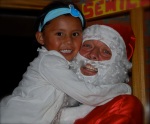
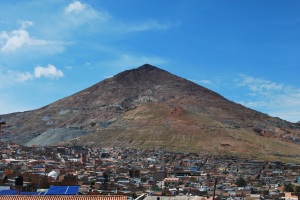
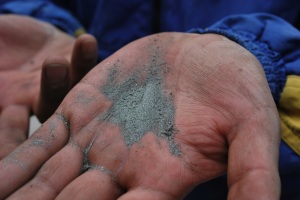
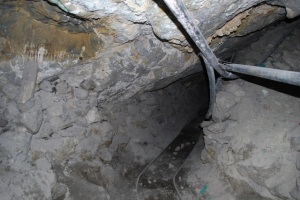
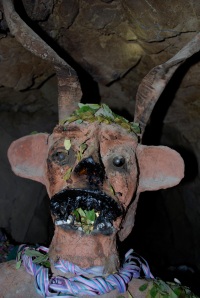
























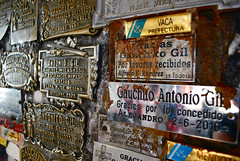


Thank you for this post. It is so well written – I love reading all of your stuff.
Thanks guys. Glad you enjoyed it. P
Hats off to you. We are still thinking about going there, but I don’t think we’ll find the courage. Thanks for the article, made an interesting read. And we definitely recommend the movie!
You were right – flashbacks abound – I’ll send you some picks 🙂
Great blog!! I felt like I was there…